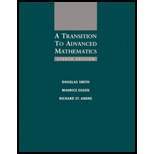
a.
To find
a.
Answer to Problem 1E
Explanation of Solution
Given:
Concept Used:
Calculation:
b.
To find
b.
Answer to Problem 1E
Explanation of Solution
Given:
Concept Used:
Calculation:
Because there is no common elements in the sets A and B.
c.
To find
c.
Answer to Problem 1E
Explanation of Solution
Given:
Concept Used:
Calculation:
d.
To find
d.
Answer to Problem 1E
Explanation of Solution
Given:
Concept Used:
Calculation:
e.
To find
e.
Answer to Problem 1E
Explanation of Solution
Given:
Concept Used:
Calculation:
f.
To find
f.
Answer to Problem 1E
Explanation of Solution
Given:
Concept Used:
Calculation:
g.
To find
g.
Answer to Problem 1E
Explanation of Solution
Given:
Concept Used:
Calculation:
h.
To find
h.
Answer to Problem 1E
Explanation of Solution
Given:
Concept Used:
Calculation:
i.
To find
i.
Answer to Problem 1E
Explanation of Solution
Given:
Concept Used:
Calculation:
j.
To find
j.
Answer to Problem 1E
Explanation of Solution
Given:
Concept Used:
Calculation:
Want to see more full solutions like this?
Chapter 2 Solutions
A Transition to Advanced Mathematics
 Elements Of Modern AlgebraAlgebraISBN:9781285463230Author:Gilbert, Linda, JimmiePublisher:Cengage Learning,
Elements Of Modern AlgebraAlgebraISBN:9781285463230Author:Gilbert, Linda, JimmiePublisher:Cengage Learning, Linear Algebra: A Modern IntroductionAlgebraISBN:9781285463247Author:David PoolePublisher:Cengage Learning
Linear Algebra: A Modern IntroductionAlgebraISBN:9781285463247Author:David PoolePublisher:Cengage Learning

